As we march deeper into the era of advanced connectivity, the rollout of innovative technologies continues to pique interest across various sectors. One such technology capturing attention is RedCap, or “reduced capability” 5G, a specification designed to optimize Internet of Things (IoT) devices. According to reports, major telecom players, T-Mobile and AT&T, are preparing to unveil devices that utilize this new 5G variant, enabling a myriad of applications from wearables to remote sensors.
The demand for more efficient communication protocols stems from the necessity for lower power consumption and broader connectivity for devices that do not require the high speeds traditionally associated with 5G. As technology advances, many products such as smartwatches, fitness trackers, and IoT sensors often find themselves limited by battery life and performance capacity. Here, RedCap seeks to bridge that gap by offering a connectivity solution that is both economical and power-efficient. Its design to transmit data at lower bandwidth whilst maintaining connectivity is seen as a game-changer for developers and consumers alike.
According to industry insiders, early 2025 will mark AT&T’s debut of NR-Light devices following their initial trials that began this year. Alternatively, T-Mobile is set to initiate its own launch before the curtains fall on 2023. While specific devices remain under wraps, there are strong indications that mobile hotspots and dongles will make it to market first. The innovations may leverage the Snapdragon X35 modem chipset, which Qualcomm unveiled last year, opening doors for various manufacturers, including those from T-Mobile and AT&T, to provide consumer-ready products.
The introduction of RedCap technology is poised to alter the very fabric of the IoT ecosystem. With more affordable connectivity options, a broader array of devices stands to benefit from seamless integration into daily life. Surveillance cameras, for instance, may see longer operational times without the constant need for recharges, making them more versatile for consumer uses. Similarly, XR (Extended Reality) glasses could thrive on this technology, enhancing user experiences without the encumbrance of bulky and power-hungry components.
As anticipation builds towards forthcoming launches, speculation arises regarding market trends and consumer adoption. While early products may be simplistic, the foundation laid by RedCap could lead to sophisticated applications that extend beyond basic connectivity. Observers are eager to see how this will be discussed at next year’s CES, a platform known for unveiling cutting-edge technology. With the introduction of RedCap, a new race in the world of 5G is set to begin, promising a future where connectivity is more pervasive and accessible than ever before.
RedCap technology signals a revolutionary step forward in the telecommunications sector, offering exciting potential for developers and consumers. As major players race to capitalize on this innovation, the way we interact with the digital world may be forever changed.


Leave a Reply
You must be logged in to post a comment.